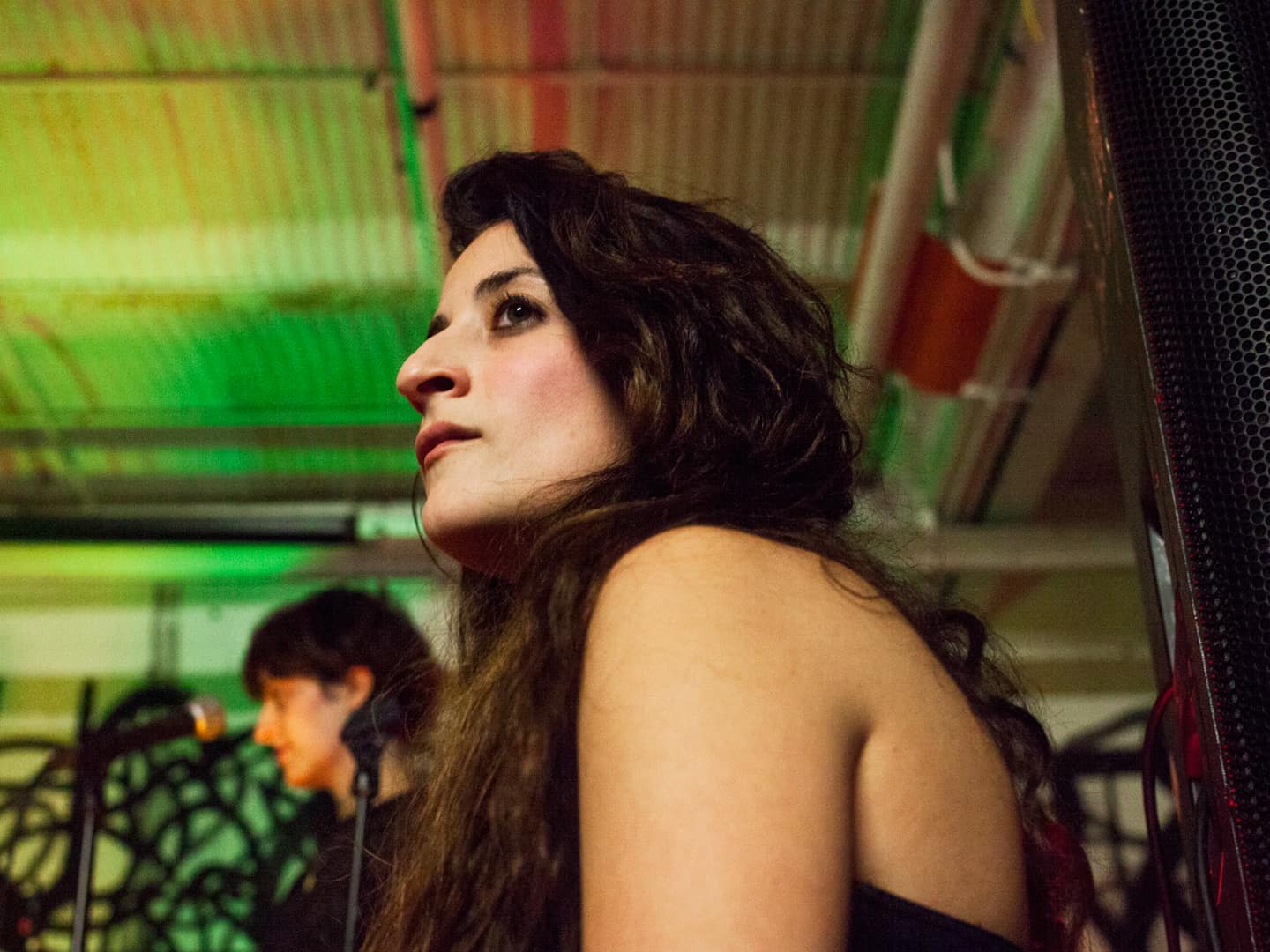
10 NYC DIY Venues That Closed This Year And Why We’ll Miss Them
Weyes Blood, Pictureplane, Ramona Lisa and more reflect on the NYC underground haunts that shuttered this year.
I went to 285 Kent Ave the first night I moved to New York. When the off-the-books Williamsburg venue—known for its tastemaking programing and a really nasty bathroom—closed for good back in January, it didn't immediately sink in. It wasn't until its neighboring DIY havens Glasslands and Death By Audio announced they'd be hosting their final shows this year, too, that I fully wrapped my head around what was going on: that street corner, a desolate stretch between South 2nd and Kent Ave, was no longer a place where you could attend a raucous party on a weekday, run into friends on the street, or kill time between sets by darting into a different show. In all likelihood, I'd probably never even go there again.
Whether it's a mostly-legal bar that hosts live music or an unlicensed warehouse, "DIY" venues are transient by nature. There's practically an unwritten contract when you frequent a truly underground spot: don't get attached, this isn't forever. But it still stings when they disappear, and this past year in Brooklyn felt particularly crushing. We said goodbye to New Age hot mess Body Actualized, endearingly sleazy hangout Wreck Room, and inclusive staple Goodbye Blue Monday (which never charged a cover, even in its darkest financial hour). There are lots more, in New York and in other places, but here's our list of 10 perfectly imperfect NYC spots that will be missed, with words from Caroline Polachek, Autre Ne Veut, Mas Ysa, and other artists who loved playing there. —Patrick D. McDermott
Founded in 2011 by Todd P.
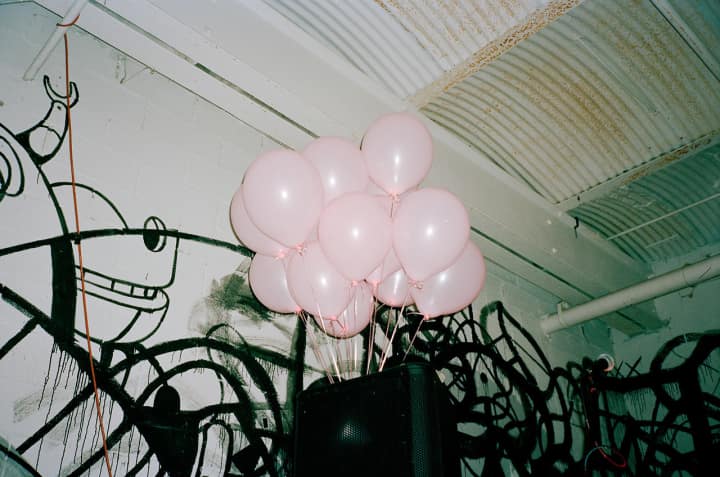 Photo by Sam Clarke
Photo by Sam Clarke
Autre Ne Veut: For a few years, north Brooklyn felt like the epicenter of culture. Obviously I'm biased because I was there, but 285 Kent (and before that, West Nile), Glasslands, and Death By Audio represented a creative performance region that actually felt both personal and culturally important—as though the things happening within the confines of that one square block could miraculously mean something more than what they were. Perhaps it wasn't as personally exhilarating as being 22 years old, trudging out to one of the earlier, more transient Todd P venues, and discovering High Places playing alongside Marnie Stern and Lightning Bolt, but then, what can trump memories of youth?
Regardless, the goals of this epicenter of north Brooklyn music were less myopic than the previous incarnation of Brooklyn DIY, more inclusive, designed to stretch the tastes of the attendees and to blur the boundaries of more segregated paradigms of cool. As a consummate sentimentalist, I feel lucky to have played and worked alongside all of the people that worked so hard for as long as they did to make it possible.
Mas Ysa: I actually didn't have any formal involvement with 285, other than playing a bunch of shows there and having a back hall passage from my bedroom to the stage. I lived in the building in a different space, in the spot where Roland and Brooke started Glasslands. Back then it was on South 1st and Kent and was called Glasshouse. Todd P and Ric and the fam over [at 285] were / are super supportive and put me on stage a bunch. There were show spaces and lofts and bars before 285, before me, and before that stuff, and there will be things to come. With Zebulon, Monster Island, Secret Project Robot, Paris London West Nile, DBA, Glasslands and more gone—who wants to be in that neighborhood anyway? Let's all move to Bloomington, Indiana.
I can get really nostalgic, and I have a lot to say on the matter—some of it controversial, some of it glowing. I am insanely lucky to have been there. I can't even look back too hard, it makes my heart heavy; there were so many little blessings and chance meetings and fuel for the fire, and night after night after night of…what a tornado of opportunity and support. People partied and worked really hard for and with each other; that is a spirit thing, not a zip code thing. I'm not sad to see it go. I'm happy it was. Ask me again in two years. I'll be sad.
Founded in 2012 by Michael Potvin and Joey Asal
Teengirl Fantasy's Logan Takahashi: Early last year, my father was in town visiting for the night, and Aurora was throwing a Mutual Dreaming party at Steel Drums. I decided to take my dad there with some friends to show him a night out in Brooklyn. We got there and the party ended up being this special bonding moment between us: he was really receptive to the situation, and seemed blown away by the loud system and the projections and the overall vibe. I was psyched to get to share with him firsthand a whole community of people that I'd become a part of in a space that I'd spent a lot of time and performed in, often alongside friends like Gatekeeper, Physical Therapy, Daniel Keller, Arca, Slava, Blondes, and Shams. I remember being in a circle on the dance floor with him and my friends, seeing him pull out moves I'd never seen before, jaws open kind of. The next moment, we look up and there are cops swarming everywhere kicking everyone out, destroying the moment. Sadly, that ended up being the last show ever at Steel Drums.
Founded in 2007 by Matt Conboy and Jason Amos
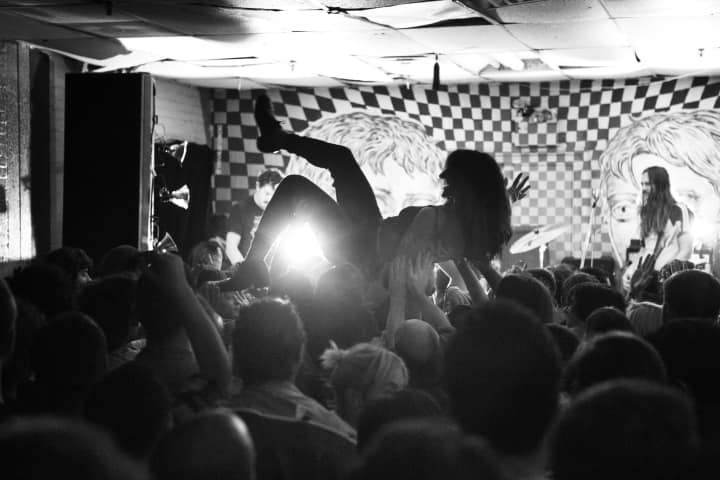 Photo by Ebru Yildiz
Photo by Ebru Yildiz
A Place to Bury Strangers' Oliver Ackerman: Death By Audio was literally my home, but more importantly for me, [it was] the home of so much inspiration and constant wonder. I loved how there would constantly be bands playing that I had never heard of, pouring their hearts out with mind-blowing performances. The people who made it all happen are my best friends and I helped out with the space in any way I could. I miss having a constant hang out spot where I would see my friends all the time.
Founded in 2012 by Ginny Benson, Joe Ahearn, Victoria Sobel, Matthew Mann, Alison Sirico, Stefan Fink, and Danny Moore. Originally Pizza Forest, under Patty Conway, Veronica Torres, Fiona Campbell, Madison Farmer and Josie Keefe
PC Worship's Justin Frye: The Ho_se started when Alaina Stamatis moved out of Le wallet in 2012. Her, Cherry, Matt, Ginny, Joe and Allison locked it in as a place to live after some mutual friends had moved out. At the time, there was a lady with 5 poodles upstairs that blasted 8 Minute Abs, so making noise wasn't an issue. I was going to use the basement as a studio, but after a few weeks it became clear that the space was destined to host the most off-kilter shows and parties in the neighborhood, so I bailed as a shareholder cause my shit would have been thrashed. Regardless, during one of the first group art shows there, I made a set of glow-in-the-dark wind chimes for the garden and hung them out back by the hose so everyone could sleep soundly during hurricanes.
That night, I remember Alaina was trying to re-establish the space, which had been having really cool shows long before as Pizza Forrest, and I dubbed it "The Hose", since it was the only place in NYC I've ever been with a real, water-pumping hose. Shortly after, someone made a flyer for an upcoming show and spelled it The Ho_se. My memory is a little hazy about the origins and first few months of the Ho_se, but that story feels right. I've seen a lot of weird shit over there, from demented Christmas dinners to melted psycho BBQ jams, from riled-up punk shows to bastardized techno raves. It was one of those places where a lot of magical things happened that I just wouldn't feel right sharing after the fact. What happened at the Ho_se stayed at the Ho_se, and is now buried in a sheath of broken future condos, shark remnants, jazz casualties, broken guitars, mushroom goo, cultivated love, and overgrown tomato plants.
Founded in 2012 by Simón Acosmist, Laura Blüer, Jenna Cecila, Reece Cox, Sasha Desree, Miles Pflanz
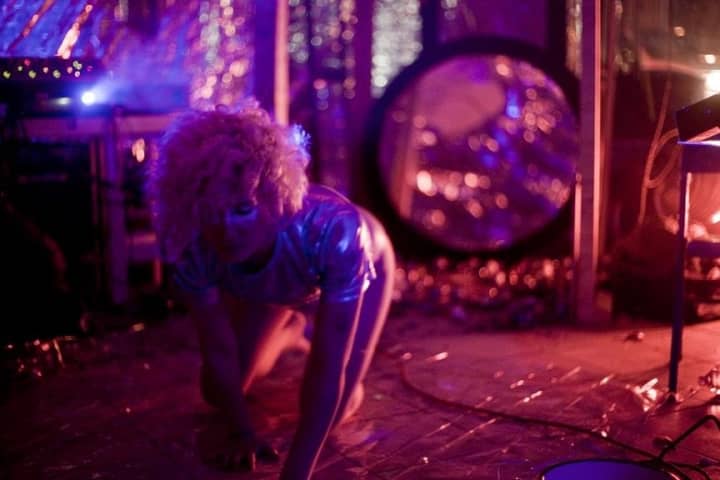 Photo by Alison Spunolith
Photo by Alison Spunolith
Pictureplane: Fitness played a large role in building a community of artists and weirdos. When I first started going there, I had just moved to Brooklyn and I met a lot of people there that would go on to be good friends of mine. I immediately gravitated to Fitness because it was really DIY and grimy and it reminded me so much of Rhinoceropolis, the DIY warehouse I helped run in Denver. At Fitness, there was a shed in the backyard where three guys slept together on one mattress and I think it was their sort of love den where they would have orgies. People slept in rooms the size of closets and everyone who lived there worked at the space also: running sound, doing the door, cleaning the gallery, and setting up art shows. It was your friendly neighborhood fully-functional anarchist warehouse, basically.
The basement, where the shows would happen, could go as late as we wanted. I remember a lot of performances with people hanging from the ceilings and making out in dark corners. There were amazing shows from Hoax, narwhalz, DJ Dog Dick, so many others, plus summer BBQ's, potlucks, and a lot of freaky DJ sets I can't remember. I had a solo exhibition of art in the gallery there and saw a lot of great art shows there too; shoutout to Reece Cox for being a great curator of that space. Towards the end, people moved away and a lot of crust punks had moved in. "Fitness" sort of deteriorated into a crusty mess. It is now a beautiful, renovated gallery called Stream, and the orgy garage has been turned into a wonderful dance and yoga studio run by my good friends, Monica and Sigrid, called Otion Front Sudios. The block on constant flux! To the future!
Founded by Brooke Baxter and Rolyn Hu in 2006
Caroline Polachek: The first time I ever went to Glasslands was around 2005 when it was called Glasshouse Gallery, but not exactly worthy of the title "gallery." It was a graffiti-covered warehouse space without a stage, and people watched from a rickety loft balcony that I was sure was going to collapse while Japanther was playing. The opening act was a shirtless guy smashing a bike, and the toilet didn't work. I loved it.
In 2008, Chairlift played for the first time at Glasslands Gallery, which became a home to the family of synth-pop and psych-folk bands that came up around that time. It was a rock that everyone counted on to be there, for both the small bands playing their debut show as first of five on a bill, to the larger bands sneaking in a slam-packed secret show between tours. There was a time when musician friends of mine worked running sound, bartending, and working the door, so it felt like second home to me.
Looking back, one of the more remarkable things about Glasslands is how it adapted, not just to survive the gentrification of Williamsburg, but with the changing aesthetic and ambition of DIY. The same way the walls changed from graffiti to murals to sleek tube lights, it was the obvious place for the shirtless guy to smash a bike, then floor toms played with shakers, then drum pads and backing tracks, then laptops and lasers. So many different and overlapping scenes called it home because of that.
Founded in 2005 by John McGillion
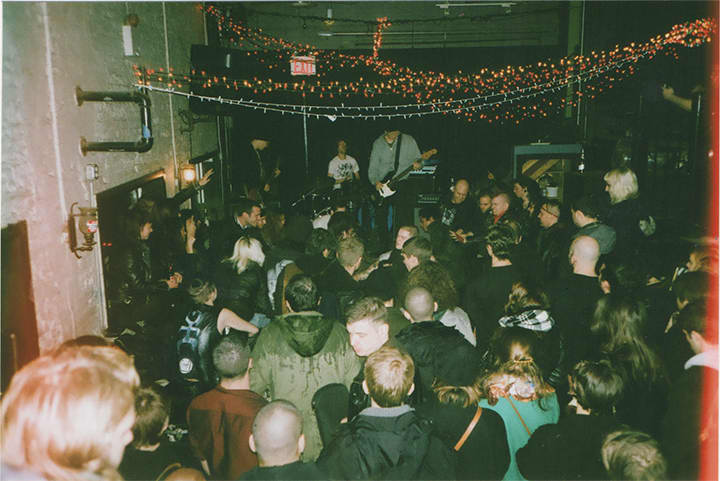 Photo by Alexander Heir
Photo by Alexander Heir
L.O.T.I.O.N.'S Alexander Heir: Lulu's was one of the few bars that I think actually respected the punk shows they hosted. Survival played there more times than I can remember, and it was the host of L.O.T.I.O.N.'s first show, as well. The staff was always super cool and helpful, hooked it up with drinks, and let the shows run without interference. I'll remember Lulu's as a spot for locals. Though it often times got pretty packed and wild, it wasn't really the spot you'd see a huge show or a really popular touring band; it was the place NYC bands would play for their friends and people could book small shows, for their own scene.
Founded by Sam Tuffnell
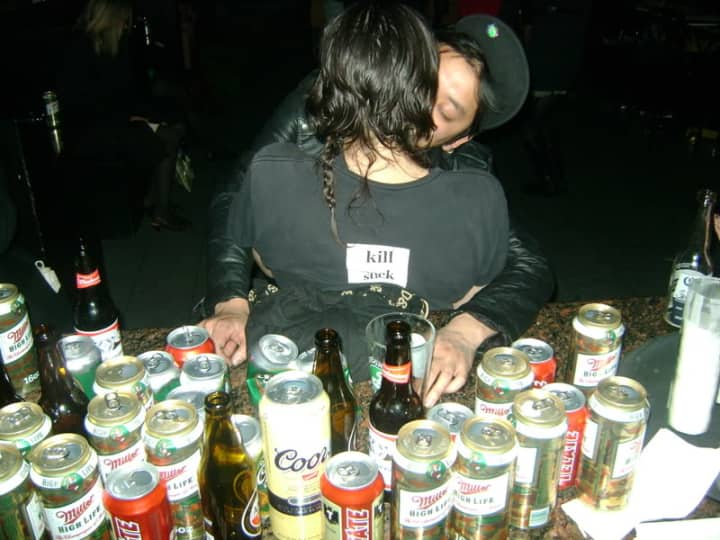 Photo by Erica
Photo by Erica
Excepter's John Fell Ryan: Wreck Room had high-ceilings and a street-level attitude. Excepter lived nearby and it became our after-show party place. Erica Kenia was the queen of the scene and transformed the room into a place where different sexes, genders, races and classes co-mingled and got down. Which is to say, the Wreck Room tapped the revolutionary, political potential of an unassuming dive bar serving cheap beer and hot wings.
Founded in 2005 by Steve Trimboli
Mal Blum: At nineteen, I was an earnest, budding, but pretty irritating songwriter. I booked myself two shows via Goodbye Blue Monday's Myspace page and I played two very bad sets. I brought five or so friends and I either bored or alienated the walk-in crowd (there was always a walk-in crowd at GBM, since there was never a cover). Here's the thing, though: Goodbye Blue Monday didn't care that I was bad and that's what was so awesome.
The booking process was such that they had live music throughout the week. So, if you wanted a time-slot and it was open, it was yours. It was a venue where you could try things out unpretentiously, which is the practice that ultimately made me better. This is what makes any of us better musicians: cutting our teeth early on live environments, where we can try things that don't work until we realize what does. That's what makes venues like Goodbye Blue Monday important and special and makes me hope a next batch of "anything goes" diy venues crop up in Brooklyn.
Founded in 2011 by Etienne Pierre Duguay, Danielle Duguay, Brian Sweeny, Jan Woo, Anna Fitzgerald, Austin Samsel, Amy Jenkins, Nick Schneider, Angelina Dreem, Jon Williams, Andrew Sellers
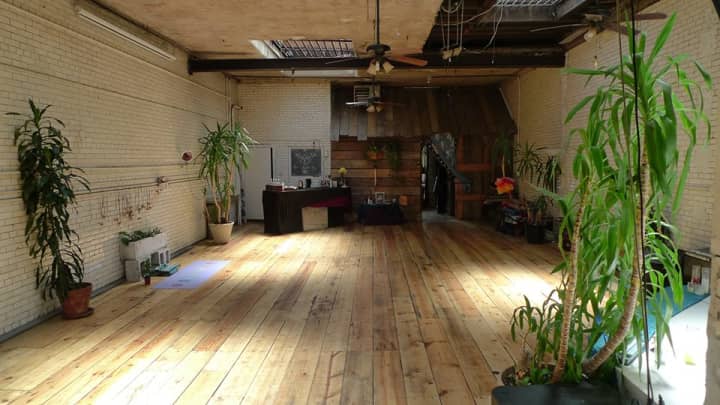 Photo by Brian Sweeny
Photo by Brian Sweeny
Silk Rhodes' Sasha Desree: I was involved with Body Actualized while it was gestating, and I watched it grow up—first as a group of witches who would chat about the occult with a few chosen boys around a circle, then as a rooftop yoga concert series. By the time it found a home in its white tile-walled, plant-covered camp-bunk dreamland, Body Actualized was already a toddler. It was definitely a magical space. I used to close out the night every once in a while with long sets of live cosmic house and soul. There was a time when it had the best curation of any DIY space in the city, hands down. One of the coolest things about that space is that it was welcoming to all generations. One night my parents came to see [my other band] Splash and danced till 6am as passed out 20-somethings sucked their thumbs in the fifth dimension. There were many moments when I thought to myself, "Is this what those legendary spots like the loft were like?" It was psychedelic, it was tasty as fuck, and most of the people there were really attractive. If I had a nickel for every time someone told me Body Actualized change their life maybe I'd have enough money to pay for the newly astronomical rent!
Weyes Blood: As much as people like to stereotype Body Actualized and are scared of what it truly stood for, it was a deeply ambitious endeavor with the sincerest of intentions. The first time I went to Body Actualized, it was just a baby. Everybody was so buzzed on this crazy, unexplainable energy. All the guys had leggings on; you could see their balls. It smelled like body odor, people were free, and all I could think was, "It's about time people combined the far out-ness of experimental music with meditation and body awareness, duh." It was as if anything were possible; everyone wanted to grow and learn. Cosmic Yoga changed my life. It was one of the deepest unions of crazy warehouse culture and transcendence I've ever experienced—the synths playing, Amy Jenkins the Queen of yoga and sexual freedom leading us in a swirling, maxed-out meditation, all my feelings about the infinite possibilities of DIY culture and spiritualism coalescing in that one moment. The shows I played there were fun, but cosmic yoga was truly a singular experience, something I still daydream about to this day.

